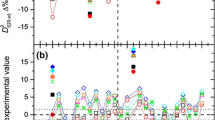Abstract
Spheres, cylinders or ellipsoids, whose hydrodynamic properties can be computed from analytical or semi-analytical expressions, have been traditionally used as low-resolution approximate descriptors of macromolecular size and shape. However, these simple geometrical bodies can seldom faithfully reproduce any detail of a macromolecular surface. A more sophisticated procedure utilizes instead ensembles of spheres (``beads'') of various diameters in an appropriate spatial arrangement to model the macromolecule. This method has not yet gained widespread application, partially because of the difficulties involved both in the generation and in the handling of the models, and because of the rather complicated mathematics involved in the computation of the hydrodynamic parameters, requiring non-trivial dedicated computer software virtually unavailable in the public-domain. A notable exception was the ``TRV'' program and its predecessors developed by the Garcι′a de la Torre's group, which have been recently updated and made available as the ``HYDRO'' package (Garcι′a de la Torre et al. 1994).
To make accessible as many aspects as possible of this powerful modelling procedure, we have assembled a set of computer programs written in C language called BEAMS (BEAds Modelling System), which are described in this paper. The main BEAMS programs provide the user with a choice of four different methods for the computation of the hydrodynamic and structural parameters of ensembles of beads, with the option of automatically generating many random conformations of linear, branched and/or looped strings-of-beads. Selected models can be visualized from any desired point of view and manipulated interactively on a high-resolution colour monitor, and plotted as two-dimensional projections on an eight colour plotter. A further option permits the calculation of the parameters for segmentally flexible models composed of two subunits. Two ancillary programs, PROMOLP (written in VisualBasic for WindowsTM) and GRUMB (written in C for general PC use) help the user in the definition of the number and radius of the beads to be used for the models, and in the interactive construction of spatially pre-defined models. BEAMS should be especially useful in the generation of low-resolution models of large-sized proteins which are difficult or impossible to solve with high-resolution techniques such as X-ray crystallography or NMR, and, in multidomain/modular proteins, in defining the overall spatial arrangement of the various domains/modules from their known 3D-structures.
Similar content being viewed by others
Author information
Authors and Affiliations
Additional information
Received: 1 September 1996 / Accepted: 1 December 1996
Rights and permissions
About this article
Cite this article
Spotorno, B., Piccinini, L., Tassara, G. et al. BEAMS (BEAds Modelling System): a set of computer programs for the generation, the visualization and the computation of the hydrodynamic and conformational properties of bead models of proteins. Eur Biophys J 25, 373–384 (1997). https://doi.org/10.1007/s002490050050
Issue Date:
DOI: https://doi.org/10.1007/s002490050050




